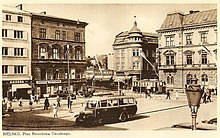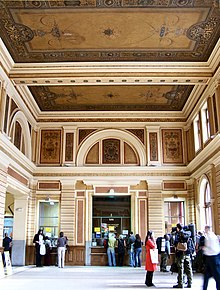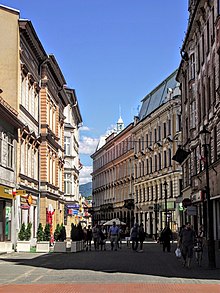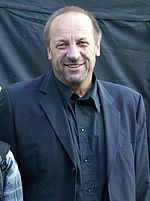Bielsko-Biała ( (![]() listen); Czech: Bílsko-Bělá, German: Bielitz-Biala, Silesian: Bjylsko-Bjoło) is a city in southern Poland, with a population of approximately 168,319 (as of December 2021) and an area of 124.5 km2 (48.1 sq mi). It is a centre of the Bielsko Urban Agglomeration with 325,000 inhabitants and is an automotive, transport, and tourism hub of the Bielsko Industrial Region. Situated north of the Beskid Mountains, Bielsko-Biała is composed of two former towns which merged in 1951 – Bielsko in the west and Biała in the east – on opposite banks of the Biała River that once divided Silesia and Lesser Poland. Between 1975 and 1998, the city was the seat of Bielsko Voivodeship and currently lies within the Silesian Voivodeship.
listen); Czech: Bílsko-Bělá, German: Bielitz-Biala, Silesian: Bjylsko-Bjoło) is a city in southern Poland, with a population of approximately 168,319 (as of December 2021) and an area of 124.5 km2 (48.1 sq mi). It is a centre of the Bielsko Urban Agglomeration with 325,000 inhabitants and is an automotive, transport, and tourism hub of the Bielsko Industrial Region. Situated north of the Beskid Mountains, Bielsko-Biała is composed of two former towns which merged in 1951 – Bielsko in the west and Biała in the east – on opposite banks of the Biała River that once divided Silesia and Lesser Poland. Between 1975 and 1998, the city was the seat of Bielsko Voivodeship and currently lies within the Silesian Voivodeship.
History
| Year | Pop. | ±% |
|---|---|---|
| 1960 | 75,527 | — |
| 1970 | 106,200 | +40.6% |
| 1980 | 163,741 | +54.2% |
| 1990 | 181,278 | +10.7% |
| 2000 | 178,611 | −1.5% |
| 2010 | 175,008 | −2.0% |
| 2020 | 169,756 | −3.0% |
| source | ||
Both city names, Bielsko and Biała refer to the Biała River, with etymology stemming from either biel or biała, which means “white” in Polish.
Bielsko

Bielsko-Biała Museum, located in the Sułkowski Castle, which was initially built as a medieval Ducal Castle of the Piast dynasty, view from Bolesław Chrobry Square
The remnants of a fortified settlement in what is now the Stare Bielsko (Old Bielsko) district of the city were discovered between 1933 and 1938 by a Polish archaeological team. The settlement was dated to the 12th – 14th centuries. Its dwellers manufactured iron from ore and specialized in smithery. The current centre of the town was probably developed as early as the first half of the 13th century. At that time a castle (which still survives today) was built on a hill.
In the second half of the 13th century, the Piast dukes of Opole invited German settlers to colonize the Silesian Foothills. As the dukes then also ruled over the Lesser Poland lands east of the Biała River, settlements arose on both banks like Bielitz (now Stare Bielsko), Nickelsdorf (Mikuszowice Śląskie), Kamitz (Kamienica), Batzdorf (Komorowice Śląskie) and Kurzwald in the west as well as Kunzendorf (Lipnik), Alzen (Hałcnów) and Wilmesau (Wilamowice) in the east. Nearby settlements in the mountains were Lobnitz (Wapienica) and Bistrai (Bystra).
After the partition of the Duchy of Opole in 1281, Bielsko passed to the Dukes of Cieszyn within fragmented Poland. The town was first documented in 1312 when Duke Mieszko I of Cieszyn granted a town charter. The Biała again became a border river, when in 1315 the eastern Duchy of Oświęcim split off from Cieszyn as a separate under Mieszko’s son Władysław. After the Dukes of Cieszyn had become vassals of the Bohemian kings in 1327 and the Duchy of Oświęcim was sold to the Polish Crown in 1457, returning to Lesser Poland after three centuries, the Biała River for next centuries marked the border between the Bohemian crown land of Silesia within the Holy Roman Empire and the Lesser Poland Province of the Kingdom of Poland and the Polish–Lithuanian Commonwealth.
With Bohemia and the Upper Silesian Duchy of Cieszyn, Bielsko in 1526 was inherited by the Austrian House of Habsburg and incorporated into the Habsburg monarchy. From 1560 Bielsko was held by Frederick Casimir of Cieszyn, son of Duke Wenceslaus III Adam, who due to the enormous debts his son left upon his death in 1571, had to sell it to the Promnitz noble family at Pless. With the consent of Emperor Maximilian II, the Promnitz dynasty and their Schaffgotsch successors ruled the Duchy of Bielsko as a Bohemian state country; acquired by the Austrian chancellor Count Friedrich Wilhelm von Haugwitz in 1743, and afterwards by Polish aristocrat Aleksander Józef Sułkowski in 1752, the ducal status was finally confirmed by Empress Maria Theresa in 1754. It remained in possession of the Polish Sułkowski family until the dissolution of the duchy in 1849, while the castle was still owned by the Sułkowskis until World War II.
After the Prussian king Frederick the Great had invaded Silesia, Bielsko remained with the Habsburg monarchy as part of Austrian Silesia according to the 1742 Treaty of Breslau.
In late 1849 Bielsko became a seat of political district. In 1870 it became a statutory city.
Biała

Austrian KK stamp first 1850 issue, cancelled BIALA
The opposite bank of the Biała River, again Polish since 1454, had been sparsely settled since the mid-16th century. A locality was first mentioned in a 1564 deed, it received the name Biała in 1584, and belonged at that time to Kraków Voivodeship. Its population increased during the Counter-Reformation in the Habsburg lands, when many Protestant artisans from Bielsko moved across the river. Though already named a town in the 17th century, Biała officially was granted city rights by the Polish king Augustus II the Strong in 1723.
In the course of the First Partition of Poland in 1772, Biała was annexed by the Austrian Habsburg Monarchy and incorporated into the crownland of Galicia. The Protestant citizens received the right to establish parishes according to the 1781 Patent of Toleration by Emperor Joseph II. Biala was head of the district with the same name, one of the 78 Bezirkshauptmannschaften in the Galicia crownland.
Modern times

Polish newspaper Wieniec-Pszczółka issued in Bielsko-Biała in 1909
Although separate, the two cities effectively functioned as one urban area known as Bielsko-Biała since the 19th century. With the dissolution of Austria-Hungary in 1918 according to the Treaty of Saint-Germain-en-Laye, both cities became part of the reconstituted Polish state, although the majority of the population was German, forming a German language island.
Some ethnic German citizens formed an anti-Polish, anti-Jewish Jungdeutsche Partei, supported financially by the Foreign Ministry of Nazi Germany. Its members smuggled weapons and waged a campaign of intimidating other German residents to leave for Germany. A considerable number of young Germans joined this Party during the mid-1930s.

Bielsko city center in the 1930s
During the German invasion of Poland, which started World War II, the Einsatzgruppe I entered Bielsko-Biała in the first half of September 1939 to torture, plunder, and murder Jews. During the war Bielsko-Biała was annexed and occupied by Nazi Germany. In 1939 Germans arrested several Polish teachers and principals who were then deported to Nazi concentration camps and murdered there. A prison for Poles was operated by the Germans in Bielsko-Biała. Many of its Jewish residents were murdered at the nearby Auschwitz extermination camp. Less than 1000 of Bielsko-Biala’s Jewish community of nearly 8000 survived the war. After the defeat of Nazi Germany in 1945, the remaining German population fled westward or were expelled. The town was polonized and gradually repopulated by Polish settlers.
Several widely known Holocaust survivors from Bielsko-Biała were Roman Frister, Gerda Weissmann Klein and Kitty Hart-Moxon, all of whom wrote accounts of their experiences during World War II.
The combined city of Bielsko-Biała was created administratively on 1 January 1951 when the two cities of Bielsko, and Biała (known until 1951 as Biała Krakowska), were unified.
Sport
Football
Podbeskidzie Bielsko-Biała(TSP) is a football team that play in the Polish Ekstraklasa.
Volleyball
BBTS Bielsko-Biala is a volleyball team that play in the Polish arena.
Geography
The city is situated on the border of historic Upper Silesia and Lesser Poland at the eastern rim of the smaller Cieszyn Silesia region, about 60 km (37 mi) south of Katowice. Administrated within Silesian Voivodeship since 1999, the city was previously capital of Bielsko-Biała Voivodeship (1975–1998).
Bielsko-Biała is one of the most important cities of the Beskidy Euroregion and the main city of the Bielsko Industrial Region (Polish: Bielski Okręg Przemysłowy ), part of the Upper Silesian metropolitan area.
Climate
Bielsko-Biała has an oceanic climate (Köppen :Cfb) with cold, damp winters and warm, wet summers. However, using the 0 °C isotherm, the climate is a Dfb-type called of humid continental climate, which explains its considerable thermal amplitude for Central Europe. The extremes may still be moderated by the western patterns and winds of this direction, which still maintains hybrid characteristics in the city’s climate. Foëhn winds help maintain a milder winter in Bielsko-Biała and average about 4 °C lower than the surrounding mountains each year. The sunniest days are between late summer and early fall, with a few months reaching 9 sunny days. In the 1960s 55 cm of snow cover was recorded.
| hideClimate data for Bielsko-Biała (1991–2020 normals, extremes 1951–present) | |||||||||||||
|---|---|---|---|---|---|---|---|---|---|---|---|---|---|
| Month | Jan | Feb | Mar | Apr | May | Jun | Jul | Aug | Sep | Oct | Nov | Dec | Year |
| Record high °C (°F) | 15.0 (59.0) |
19.0 (66.2) |
22.8 (73.0) |
29.0 (84.2) |
30.7 (87.3) |
33.9 (93.0) |
35.4 (95.7) |
36.4 (97.5) |
34.1 (93.4) |
26.4 (79.5) |
23.1 (73.6) |
18.3 (64.9) |
36.4 (97.5) |
| Average high °C (°F) | 2.2 (36.0) |
3.5 (38.3) |
7.6 (45.7) |
14.1 (57.4) |
18.6 (65.5) |
21.9 (71.4) |
24.0 (75.2) |
23.9 (75.0) |
18.6 (65.5) |
13.5 (56.3) |
8.2 (46.8) |
3.3 (37.9) |
13.3 (55.9) |
| Daily mean °C (°F) | −0.9 (30.4) |
0.2 (32.4) |
3.5 (38.3) |
9.0 (48.2) |
13.4 (56.1) |
16.8 (62.2) |
18.7 (65.7) |
18.5 (65.3) |
13.8 (56.8) |
9.3 (48.7) |
4.8 (40.6) |
0.3 (32.5) |
9.0 (48.2) |
| Average low °C (°F) | −3.9 (25.0) |
−3.0 (26.6) |
−0.2 (31.6) |
4.1 (39.4) |
8.4 (47.1) |
12.0 (53.6) |
13.7 (56.7) |
13.5 (56.3) |
9.6 (49.3) |
5.7 (42.3) |
1.6 (34.9) |
−2.6 (27.3) |
4.9 (40.8) |
| Record low °C (°F) | −27.4 (−17.3) |
−29.6 (−21.3) |
−20.7 (−5.3) |
−8.5 (16.7) |
−3.1 (26.4) |
−0.2 (31.6) |
4.3 (39.7) |
2.6 (36.7) |
−2.4 (27.7) |
−8.6 (16.5) |
−19.8 (−3.6) |
−26.0 (−14.8) |
−29.6 (−21.3) |
| Average precipitation mm (inches) | 45.2 (1.78) |
46.6 (1.83) |
58.6 (2.31) |
67.8 (2.67) |
128.7 (5.07) |
131.6 (5.18) |
143.2 (5.64) |
92.0 (3.62) |
110.2 (4.34) |
72.7 (2.86) |
56.8 (2.24) |
45.2 (1.78) |
998.3 (39.30) |
| Average extreme snow depth cm (inches) | 21.2 (8.3) |
27.4 (10.8) |
19.7 (7.8) |
9.9 (3.9) |
0.5 (0.2) |
0.0 (0.0) |
0.0 (0.0) |
0.0 (0.0) |
0.0 (0.0) |
4.1 (1.6) |
9.5 (3.7) |
14.2 (5.6) |
27.4 (10.8) |
| Average precipitation days (≥ 0.1 mm) | 17.03 | 16.34 | 15.57 | 13.93 | 16.80 | 15.73 | 15.60 | 12.77 | 13.13 | 14.20 | 14.57 | 15.77 | 181.44 |
| Average snowy days (≥ 0 cm) | 26.7 | 25.3 | 20.7 | 6.5 | 0.2 | 0.0 | 0.0 | 0.0 | 0.0 | 2.8 | 10.9 | 23.5 | 116.6 |
| Average relative humidity (%) | 81.4 | 78.5 | 73.6 | 67.3 | 71.4 | 72.8 | 71.9 | 72.3 | 77.5 | 79.0 | 80.8 | 82.4 | 75.7 |
| Source 1: Institute of Meteorology and Water Management | |||||||||||||
| Source 2: Meteomodel.pl (records, relative humidity 1991–2020) | |||||||||||||
Economy and Industry

Locally designed and produced Margański & Mysłowski EM-11 Orka business long range small aircraft
Bielsko-Biała is one of the most business friendly medium size cities in Poland. In the 2014 ranking of the ‘Most Attractive Cities for Business’ published yearly by Forbes the city was ranked 3rd in the category of cities with 150,000–300,000 inhabitants. About 2% of people are unemployed (compared 5.8% for Poland). Bielsko-Biała is famous for its textile, machine-building, and especially automotive industry. Four areas in the city belong to the Katowice Special Economic Zone. The city region is a home for several manufacturers of high-performance gliders and aircraft.
Transport

Interior of the main railway station (of several) in Bielsko-Biała, 28 April 2006
Road transport
Bielsko-Biała is located within a short distance to Czech and Slovakian borders on the crossroads of two Expressways (S1 and S52) connecting Poland with Southern Europe:
- Expressway S1 connects the city with Slovakia via the border town Zwardoń.
- Expressway S52 connects the city with the Czech Republic via the border town Cieszyn.
Bielsko-Biała is connected with the rest of Poland by the dual carriageway DK1 road running to Tychy where it intersects the Expressway S1 and further to Katowice where it intersects the Motorway A4.
It is planned to extend S1 north along the existing dual carriageway DK1 from Bielsko-Biała to Tychy and Katowice, thus building an expressway connection of the city with the national motorway network of Poland. National Road DK52 connects Bielsko-Biała with Kraków in the east. The most important interchange in the area is the cloverleaf north of Bielsko-Biała where S1, DK1 and S52 meet.
Rail transport
Bielsko-Biała is connected by direct train services with the following large Polish cities (November 2014): Bydgoszcz, Gdańsk, Gdynia, Katowice, Kraków, Łódź, Olsztyn, Opole, Szczecin, Toruń, Warszawa (Warsaw), Wrocław.
Airports
There are 3 international airports within the 90 km distance from Bielsko-Biała, all serving connections with major European cities: Katowice International Airport, Kraków John Paul II International Airport, Ostrava Leoš Janáček Airport.
Sights

City Hall
Ulica 11 Listopada, the city’s most notable pedestrian zone
Bielsko-Biała is known for its Art Nouveau architecture and is often referred to as Little Vienna. Sights include:
- The Bielsko-Biała Museum, housed in the castle of the Dukes of Cieszyn from 15th century, later Castle of the Sułkowski princes
- Bielsko-Biała City Hall built in 1897
- Ulica 11 Listopada (“November 11 Street”), the main pedestrian zone of the city center
- Plac Bolesława Chrobrego (“Bolesław the Brave Square”), the main square in the city center
- Frog House (Kamienica Pod Żabami), an Art Nouveau mansion
- The only statue of Martin Luther in Poland.
- Bielsko-Biała Central Railway Station built in 1888
- BWA Bielsko-Biała Gallery of Art
- St. Nicholas Cathedral built in 1447 and rebuilt in 1909–1910
- Polish Theatre in Bielsko-Biała built in 1890
- St. Stanislaus Church, Bielsko-Biała, the city’s oldest church, built in the Middle Ages in Gothic style
- Jewish Cemetery, founded in 1849
- Weaver’s House Museum, Dom Tkacza, reconstructed workshop of a draper
- Museum of Technology and Textile Industry
- Szyndzielnia mountain located within the city borders and the Szyndzielnia Cable Car
- Dębowiec ski slope
Apart from being an attractive destination itself the city is a convenient base for hiking in Silesian Beskids and Żywiec Beskids as well as for skiing in one of the most popular Polish ski resorts Szczyrk (located 18 km (11 mi) from the city centre) and in a couple of smaller nearby ski resorts.

Patria House

Polish Theatre

Main post office

The Pod Żabami Townhouse – an example of Art Nouveau architecture in the city
Districts
- Aleksandrowice
- Biała
- Hałcnów
- Kamienica
- Komorowice Śląskie i Komorowice Krakowskie
- Leszczyny
- Lipnik
- Mikuszowice Śląskie and Mikuszowice Krakowskie
- Olszówka Dolna and Olszówka Górna
- Stare Bielsko
- Straconka
- Wapienica
Education
- University of Bielsko-Biała
- The Academy of Computer Science and Management
- Bielska Wyższa Szkoła im. Józefa Tyszkiewicza w Bielsku-Białej
- The School of Administration in Bielsko-Biała
- Bielsko-Biała School of Finances and Law
- Wyższa Szkoła Ekonomiczno-Humanistyczna
- Teacher Training College of Bielsko-Biała
Politics
Bielsko-Biała constituency
Senators from Bielsko-Biała constituency:
- Agnieszka Gorgoń-Komor (Civic Platform)
Members of Sejm from Bielsko-Biała constituency:
- Przemysław Drabek (Law and Justice)
- Grzegorz Gaża (Law and Justice)
- Kazimierz Matuszny (Law and Justice)
- Grzegorz Puda (Law and Justice)
- Stanisław Szwed (Law and Justice)
- Mirosława Nykiel (Civic Platform)
- Małgorzata Pępek (Civic Platform)
- Mirosław Suchoń (Poland 2050)
- Przemysław Koperski (Democratic Left Alliance)
Municipal politics
Mayor
- Mayor – Jarosław Klimaszewski (PO)
- Deputy Mayor – Przemysław Kamiński
- Deputy Mayor – Adam Ruśniak
- Deputy Mayor – Piotr Kucia
City council
- President of the council – Dorota Piegzik-Izydorczyk (PO)
- Deputy Chairman – Piotr Ryszka (PiS)
- Deputy Chairman – Jacek Krywult (KWW JK)
Sports

Stadion Miejski
The city co-hosted the 1978 UEFA European Under-18 Championship and 2019 FIFA U-20 World Cup.
Major teams and athletes
- TS Podbeskidzie Bielsko-Biała – men’s football team playing in the Ekstraklasa, Poland’s top division.
- BTS Rekord Bielsko-Biała – men’s futsal team playing in Polish Futsal Ekstraklasa, Polish Champions 2013/2014, Polish Cup and Supercup winners 2012/2013.
- BKS Stal Bielsko-Biała – women’s volleyball team playing in Polish ORLEN Liga , Polish Champions 1988, 1989, 1990, 1991, 1996, 2003, 2004, 2010; Polish Cup winners 1955, 1979, 1988, 1989, 1990, 2004, 2006, 2009.
- BBTS Siatkarz Original Bielsko-Biała – men’s volleyball team playing in Polish Plus Liga.
- Sebastian Kawa, member of the local aeroclub, is the eight times World Champion, World’s most accomplished glider competition pilot in history, World’s (FAI) leading glider competition pilot (currently number two in the world rankings of the FAI Gliding Commission) and the current World Champion in Standard Class and 15m Class.
- Trauda (Gertruda) Dawidowicz married Fuchs, pre-war multi-champion swimmer free-style.
Notable people

Urszula Dudziak
Zbigniew Preisner

Wojciech H. Zurek
- Adam Broż (born 1935), art historian and journalist
- Heinrich Conried (1855–1909), Austrian theatre director
- Marek Dopierała (born 1960), sprint canoeist, Olympic medallist
- Piotr Fijas (born 1958), ski jumper
- Alfred Hetschko (1898–1967), music educator
- Adolf Hyła (1897–1965), painter and art teacher
- Jolanta Januchta (born 1955), middle-distance runner
- Małgorzata Klimek (born 1957), mathematical physicist
- Jacek Koman (born 1956), actor and singer
- Maria Koterbska (born 1924), singer
- Przemysław Lechowski (born 1977), classical pianist
- Tadeusz Pietrzykowski (1917–1991), boxer and soldier, known as the “boxing champion of Auschwitz”
- Grzegorz Pilarz (born 1980), volleyball player
- Radosław Piwowarski (born 1948), film director, screenwriter and actor
- Jerzy Porębski (born 1957), film producer and screenwriter
- Zbigniew Preisner (born 1955), film score composer
- Renata Przemyk (born 1966), singer and songwriter
- Aneta Sablik (born 1989), singer-songwriter
- Franz Sauer (1894–1962), organist
- Oswald Seeliger (1858–1908), German zoologist
- Kriss Sheridan (born 1989), Polish-American singer, songwriter, actor, model and traveler
- Josef Strzygowski (1862–1941), Polish-Austrian art historian
- Jan Szarek (1936–2020), bishop of the Evangelical-Augsburg Church in Poland
- Sabina Wojtala (born 1981), figure skater
- Jakub Wolny (born 1995), ski jumper
- Aleksander Zawadzki (1798–1868), Polish naturalist
- Emil Zegadłowicz (1888–1941), poet, prose writer, novelist, playwright and translator
- Sigmund Zeisler (1860–1931), German-Jewish lawyer
- Wojciech Zurek (born 1951), theoretical physicist
Twin towns – sister cities
Bielsko-Biała is twinned with:
 Acre, Israel
Acre, Israel Baia Mare, Romania
Baia Mare, Romania Besançon, France
Besançon, France Berdyansk, Ukraine
Berdyansk, Ukraine Frýdek-Místek, Czech Republic
Frýdek-Místek, Czech Republic Grand Rapids, United States
Grand Rapids, United States Kirklees, United Kingdom
Kirklees, United Kingdom Kragujevac, Serbia
Kragujevac, Serbia Nyíregyháza, Hungary
Nyíregyháza, Hungary Szolnok, Hungary
Szolnok, Hungary Třinec, Czech Republic
Třinec, Czech Republic Ustka, Poland
Ustka, Poland Wolfsburg, Germany
Wolfsburg, Germany Žilina, Slovakia
Žilina, Slovakia


